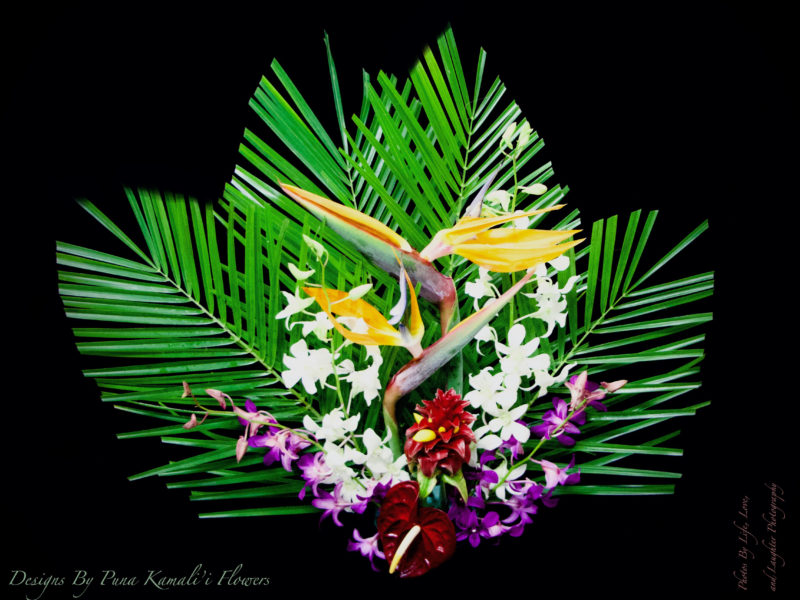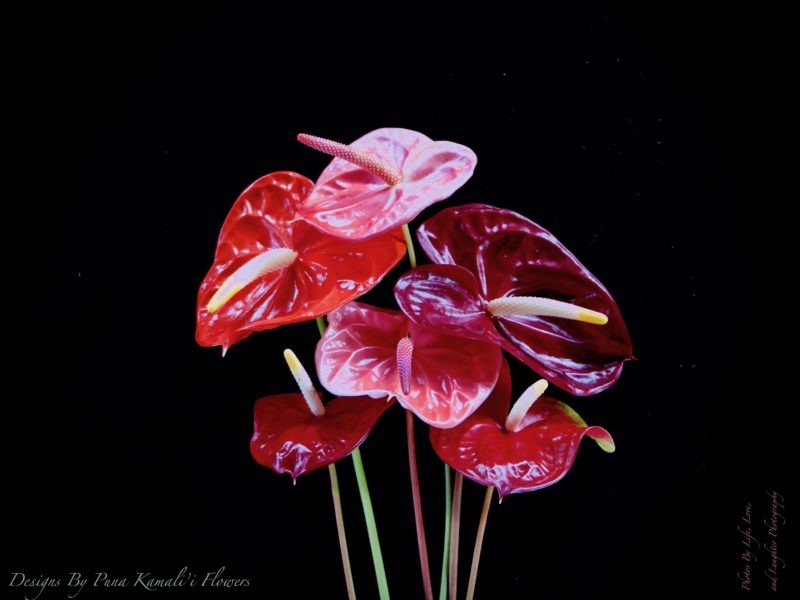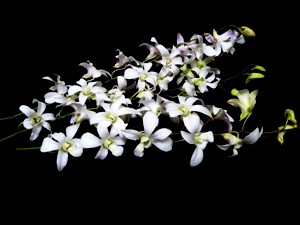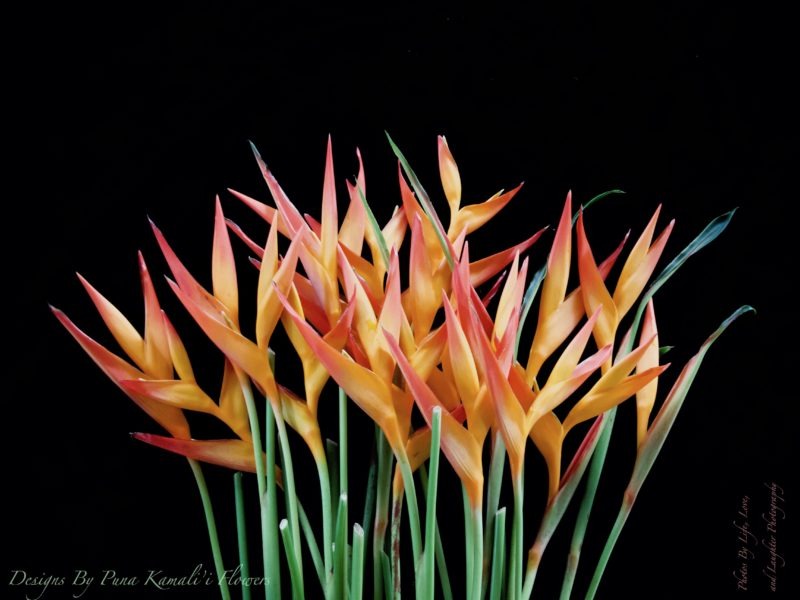Hawaiian Tropical Flowers, Plant, and Lei Care Information
Puna Kamali’i Flowers, Inc. Hawaiian Tropical Flowers are cut farm fresh, professionally packaged for shipment and should arrive in excellent condition. The instructions below will help ensure you get the maximum flower life and enjoyment from your tropical bouquet.
1. It is important to unpack the Hawaiian Tropical Flowers immediately. Do not refrigerate.
2. To restore plant cells and extend vase life, immerse entire stems in water at room temperature for 10 minutes immediately after cutting one-fourth to inch from each stem. Cutting at an angle will allow maximum water absorption and make them easier to arrange.
3. Always make sure your Hawaiian Tropical Flowers have plenty of water as tropical flowers typically need water. Misting flowers daily will help to extend vase life and keep a fresh appearance. Change flower water and trim flower stems every few days.
4. To control Hawaiian Tropical Flowers water odor and prevent bacterial buildup, you may wish to add a few drops of bleach into the water.
5. Keep Hawaiian Tropical Flowers out of direct sunlight and breezy areas and maintain temperature above 45° Fahrenheit. Also, avoid placing flowers near fireplaces, stoves and strong drafts.
6. Hawaiian Tropical Flowers may be arranged into one or more bouquets. Place green foliage behind flowers and try to set the flowers at different heights, start with the tallest and work down. Use a favorite vase and your artistic abilities to create your own special island paradise!
Individual Flowers
ANTHURIUMS

Place flower and stem, in cool tap water for at least 10 minutes and arrange. Repeat the soaking process every three days. Anthuriums should be kept with stems in fresh water at room temperature (never below 55° F). Mist heads with water daily and keep them from direct breezes and sunlight. As soon as receiving Hawaiian Tropical Flowers, cut off at least one half-inch from bottom of each stem. Immediately immerse the entire flower, including
DENDROBIUM ORCHIDS
Cut one-half inch off from bottom of each spray;  immerse in cool tap water, both flower and stem, for 10 minutes. Arrange, and repeat process every three days, or place spray in container, which allows two inches of the stem to be covered with water. Refrigerate until ready to use. Mist with water daily and keep them from direct breezes and direct sunlight.
immerse in cool tap water, both flower and stem, for 10 minutes. Arrange, and repeat process every three days, or place spray in container, which allows two inches of the stem to be covered with water. Refrigerate until ready to use. Mist with water daily and keep them from direct breezes and direct sunlight.
HELICONIAS
Remove leaves from stem as desired. Cut off one inch of the stem and place immediately in fresh water at room temperature. To improve the appearance of the bracts, wash them in water with a little detergent and rinse them with fresh water. Do not refrigerate.
BIRD OF PARADISE
Cut off one inch of the stem and immediately place in fresh water at room temperature. To bring out extra flowers, insert your thumb inside the unopened sheath through the open upper part of the sheath. Gently remove the membrane that separates each flower by cutting it off. Refrigerate as needed to keep fresh.
GINGERS
Cut off one inch from bottom of each stem. Completely immerse the flower and stem in fresh water at room temperature for 10 minutes. Do not refrigerate.
HAWAIIAN FOLIAGE
Upon receipt of foliage, trim off one-inch from bottom of each stem and immerse foliage in fresh water at room temperature for 10 minutes. Keep stems in two inches of water in container. Refrigerate until ready for use.
Plant Care
ANTHURIUM PLANT CARE
WATERING
Anthuriums can tolerate dryness around the root ball, but should be watered thoroughly and allowed to dry slightly before watering again. Allowing the plant to dry out will greatly slow down the growth rate. Drying out can also cause the tip to burn and root damage, while over watering can also cause root damage and yellowing of the leaves.
LIGHT
Anthuriums placed indoors will take about as much light as you can provide them with, but no direct sunlight. Lower levels of light will slow down or stop flowering. Outdoors, the plant will tolerate lower light levels as they grow in some of the shadiest areas in their natural habitat. Leaves emerging under lower light may stretch and/or become distorted in shape.
FERTILIZER
A slow time release fertilizer such as Miracle Grow spikes work well. Fertilizing should not be an issue for quite a few months.
PESTS AND DISEASE
Anthuriums are susceptible to the usual pests that visit indoor plants, such as aphids, scales, mealy bugs and thrips. Thrips and “mealy” are found more on new growth. You can also find aphids feeding on the flower buds. Scales seem to be particularly fond of the tough bird nest type. The best method of insect control is to monitor your plants and treat them before they get out of hand. There are some “insecticidal soaps” which work well on the soft insects, but scales may need a stronger insecticide. Under low humidity conditions spider mites may show up. One of the best ways to stay clear of the use of chemicals is with periodic wiping of the foliage and a gentle spray of water. Make sure not to forget the undersides.
The biggest disease problem that you will face indoors is rhizoctinia. This is caused by high temperature and humidity coupled with soil that is poorly drained. Don’t over water and if you must replant, use a well drained soil, for that will be your best defense. Chemically, rhizoctinia can be controlled with a wide range of fungicides. The best approach is prevention via cultural practices.
ORCHID PLANT CARE
WATERING
Keep evenly moist while in active growth. Allow to dry between waterings after growth is mature (indicated by a terminal leaf). Our plants arrive in a course growing medium which facilitates complete drainage.
LIGHT
Sufficient light is important for healthy growth and flower production. Provide bright light to 50 percent sun. In the home, an east, west or lightly shaded south window. In a greenhouse, about 30 to 50 percent full sun. Under lights, four 40 watt fluorescent tubes and two 40 watt incandescent bulbs directly over plants.
FERTILIZER
Should be provided on a regular basis during the active growing period. A good general rule is to apply a balanced (10-10-10 or 12-12-12 or similar ratio). Fertilize every week at one quarter to one half of the recommended dilution specified on the container.
TEMPERATURE
Mature plants need a 15 to 20° F difference between night and day. Provide nights of 60 to 65 F; days of 75-90° F are beneficial if humidity and air circulation are increased. Low temperatures (below 50° F) may cause leaf drop.
HUMIDITY
Orchids need 50 to 60 percent. In the home, place on trays over moistened pebbles. In greenhouse, use a humidifier if conditions are too dry.
RE-POTTING
Should be done every two to three years before mix loses consistency (breaks down). Pot firmly in medium, giving aeration and ample drainage, allowing enough room for two years’ growth. Many orchids, grow best in pots small for the size of the plant.
LEI CARE
After receiving your leis, spray lightly with water as needed to moisten them. Do not over mist them so that they are dripping wet. Put them into an aerated plastic bag and place them in the vegetable bin of your refrigerator if not too cold, or in a cool but not cold location. The best temperature to store them is around 55 – 60° F. Some vegetable bins are colder than the recommended temperature. Leis should last for 3-5 days from the date we ship them. Remember, leis will brown and be unusable if placed in too cold or breezy a location — please check your storage area for the proper conditions before placing them into storage.
